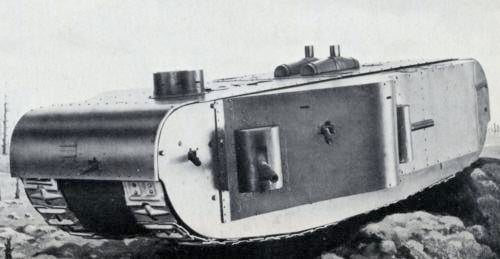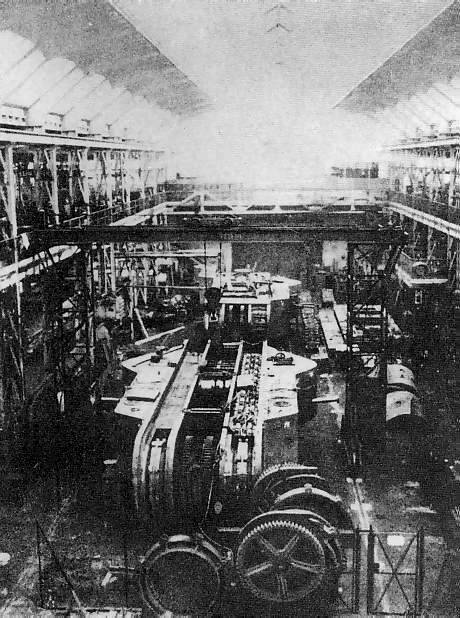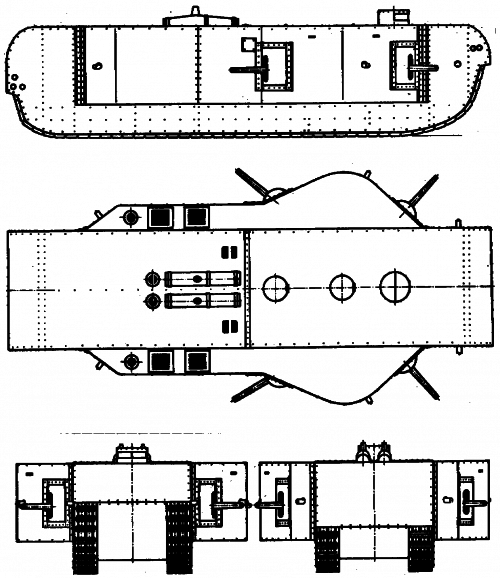Superheavy tank "K-Wagen" ("Colossal")

In May 1918, an Italian officer, an apologist for the military aviation J. Douai planned to publicize his views in the form of the science-fiction novel “Winged Victory”. In the book he "supplied" Germany with two thousand "colossal tanks A group of 4000 tons (!) In weight, with 6 diesel engines of 3000 hp. (2 of them spare), at a speed of 4 km / h, spraying incendiary liquid over a semicircle with a radius of 100 m ... the crew is only 2 people. ” Such monsters were needed by the Douai solely in order to overshadow the power of the “inter-allied air army” that he proposed, crushing the German and Austrian armies in the novel with blows to the rear communications. Of course, in fact, they did not intend to build such monsters in Germany, but the idea of a "mobile fortress" nevertheless found its extreme expression in the form of the first superheavy tank embodied in metal.
Already at the end of March 1917, the Headquarters of the High Command issued demands for a “supertank” weighing up to 150, t. Volmer received a corresponding task from the Inspectorate of Automotive Forces. The War Department approved the K-Wagen project (Kolossal-Wagen or simply Kolossal) 28 of June 1917 of the year. It was assumed that the tank would have 30-mm armor, two or four 50 caliber guns - 77 mm, four machine guns, two flamethrowers, 18 crew, two 200 engines - 300 HP, can overcome the moor width up to 4 m. project design and construction of the first sample was taken a year, but the High command to shorten this period to eight months. The program looked solid - construction 100 tanks with an initial order for 10. The estimated cost of such a machine - not less than 500 thousand Reichsmarks.. The designers had a difficult task - most of the components and parts had to be developed anew.

The scheme of the "K" in general, borrowed from the British: the caterpillars covered the hull, and the weapons - 4 guns and machine guns - were installed in wide sponsons and in the embrasures. However, the mutual arrangement of the branches was similar to the A7VU: the control and combat departments were in front, the engine-transmission section was behind. At the same time fighting compartment without sponso-new and power pack takes approximately an equal volume of the body. The crew was again a record - 22 person.
In the department of management placed two drivers. In the front of the tank, a cylindrical control room (turret) was mounted on the roof of the tank, with perimeter viewing slots and a roof hatch. The cabin was intended for the tank commander and artillery officer.
Housing tank going from large rolled sheets are fastened to the frame of rivets and bolts. Removable sponsons had a complex shape. In the oblique front and rear walls of the broadened part of the sponson, there were gun embrasures in which an 77-mm caponier gun with a semi-automatic shutter was installed. The swinging part of the gun was mounted on a swivel pedestal with a semi-cylindrical shield and a fencing breech. To the left of the fence was the seat of the gunner. For pickup he used a telescopic sight and coaxial flywheels. The front wall located at the corner sponsons MG.08 installation gun. The same machine gun installations were in the narrow rear part of the sponson, in the sides and front sheet of the control compartment.

The fire from the rear machine guns had to lead mechanics, whose main responsibility was to monitor the state of the engine and transmission. Installation of weapons met all the same requirements of a circular attack - in any direction the tank "K" could concentrate fire of approximately equal density. On the roof of the sponsons there were vents.
Already design weight of the tank made to look more powerful engines. For powerplant group selected two engine "Daimler" in 650 hp Exhaust pipe with silencers and radiators to be displayed on the roof at the rear of the housing. Gasoline inventories was 3000 liters. The originality of the design differed in the chassis: skating rinks with flanges were not fastened to the tank body, but to the tracks of the tracks. The hull on each side was covered by rail guides, along which the tracks “ran in”. Trucks assembled with bolts and rivets. The drive wheel is of a rear location. The upper branches of the tracks with front and rear descending branches were covered with armor-roof, which turned into curved armored screens.
It was planned to equip the communications tank - a place for a radio operator was taken in front of the engine compartment. For transport by rail "K" can be disassembled into 15 - 20 parts. It was rather difficult to understand how it was supposed to carry out the combat use of such colossi. Obviously, the command believed that it was possible to break through the front of the allies in several places (remember the fantastic “Kaiser machine”) with the help of mobile fortresses — an idea that had arisen in those years in all the belligerent countries. However, already 18 of October 1917, the Experimental Division of the Inspectorate of the Automobile Forces, recognized that a tank of type "K" is suitable only for positional warfare. Armament "K" was a artillery and machine gun batteries installed in one "mobile forte." Large dead space in the field of view from the cockpit controls were tolerated only for the "position" of the tank.
The contract for the construction of five copies of “K” was concluded with the Ribe ball bearing plant in Berlin-Weissensee, and for the other five with the Vagonfabrik Wegman in Kassel. Tank construction began in April 1918-th. By the end of the war, one tank was almost completed on the Ribe; an armored hull and a set of basic units and assemblies, except for engines, were ready for the second. After the defeat of the Germans and the conclusion of the Treaty of Versailles, all this went down for scrap.
Note that after a quarter of a century, two of the heaviest tanks, the 180-ton Maus, were also built in Germany, which also did not take part in any battle. It is curious that in both world wars, after the turn of events was not in their favor, the German military leadership issued assignments and allocated resources to the “supertanks”. Both times, the designers laid a number of original ideas and solutions into these monsters, and both times the colossi found themselves in the role of a stillborn child.

Information